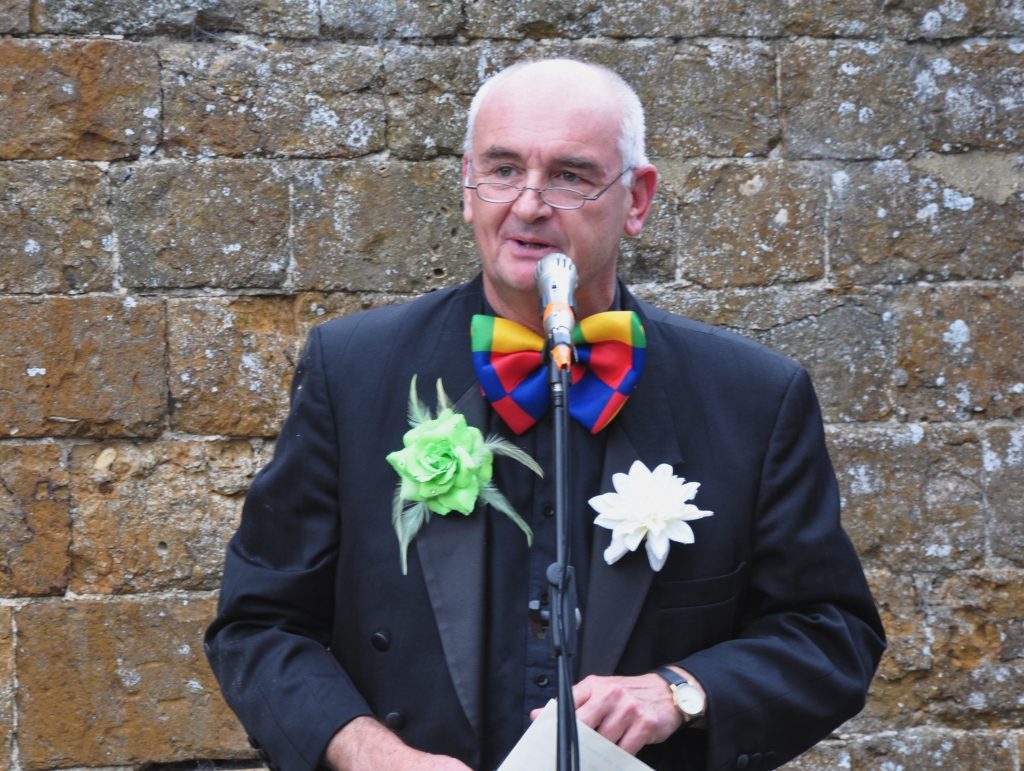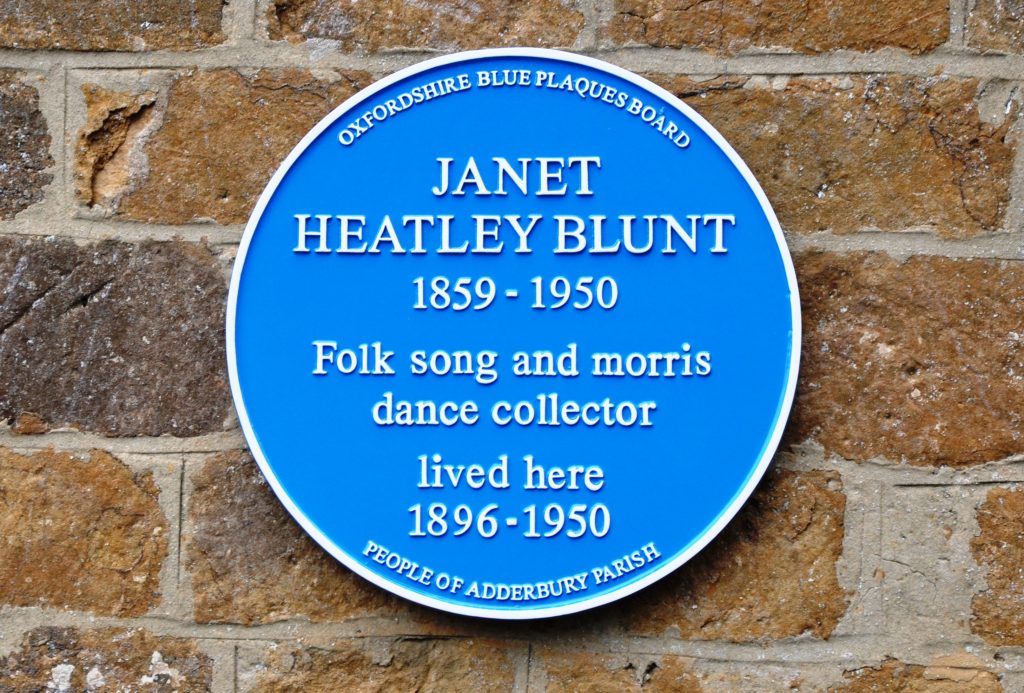The following text was the introductory talk given by Bryan Sheppard on September 27th 2009 at the unveiling of the Blue Plaque in memory of Janet Blunt.
Bryan gave the manuscript to AHA after the talk. It therefore seems fitting after the untimely death of Bryan to print the talk on the History Association website.

Janet Blunt was born in India on 28th April 1859, the daughter of Charles Harris Blunt, a Major General in the Royal Bengal Artillery stationed at Umballa, a military station in the Punjab. After the death of Janet’s mother, Mary, in 1892, Charles retired from active service and brought his family back to England, and lived here at Halle Place. After he died, Janet, a spinster, became a benevolent ‘lady of the manor’.
Between 1907 and 1931 Janet made a remarkable collection of songs, carols and Morris dances in this village. She was inspired initially by the recollection of songs that her father sang, along with the work of Cecil Sharp and his contemporaries. Whereas other collectors travelled and cycled long distances in their chosen areas of research, Miss Blunt was able to amass a significant collection of songs and Morris dances from the community in which she lived; leaving us with a vivid and priceless record of social music making and Morris dancing.
Janet was effectively the Lady of the Manor in Adderbury West and as such was very much involved in running the estate she had bought from the Risley family. Through her contacts with the tenants and villagers, she was able to note down 125 songs from 46 different singers living in Adderbury and the surrounding parishes. Indeed, people in the village remembered as children hiding under the open window and listening to the old men singing with Miss Blunt playing the piano and writing down the songs and tunes.
Janet Blunt’s housemaid Winnie Wyatt had worked for her from the age of 13. When Miss Blunt died Winnie’s cottage was left to her – (the building-over there). After the funeral when Halle Place was being cleared, most of Janet’s song books and manuscripts were heaped into a number of cardboard boxes and put out for the bonfire! Luckily Winnie knew how important the songs and dances were, saved them and sent them off to the English Folk Dance and Song Society. These manuscripts are now available on line for everyone to see. Without Winnie Wyatt, none of these wonderful old songs and indeed the majority of the Adderbury Morris dances would have survived!
William ‘Binx’ Walton was one of Janet Blunt’s best informants. He was a stonemason, shopkeeper and the landlord of the Wheatsheaf pub up on the Oxford Road. He gave her songs and the local Morris dances which he remembered from his dancing days in the mid 19th century. The Waltons were also bell ringers and Binx recounted how they once took beer to the belfry, got drunk and fell down the stairs and were subsequently banned from the Church.
Perhaps the most famous part of Janet Blunt’s collecting was the detailed notes on the distinctive Adderbury Morris dances, largely gleaned from William Walton and his brother John. The Walton brothers demonstrated the dances on the lawn here at Halle Place using maids and other servants to make up the dance sets! Janet spent many hours meticulously noting down the dances and tunes, and describing the dances in layman’s terms in such detail that they could be reconstructed by the revival Morris team in the 1970’s – but more of that later.
Interestingly there had been an earlier revival of Morris dancing in Adderbury in 1908 at the school in the village. A lady came from Oxford, possibly from Mary Neale’s Esperance Dancers, and, with the help of two old villagers, probably the Waltons, taught the dances to the children. (It is probable that it was in fact one of the Miss Leigh Hoskins who taught the children in 1908 – see Tim Radford’s article, “Female Influences on Morris Dance in Adderbury”, elsewhere on this website.)
One of those pupils was Charlie Coleman a well known village resident and son of the local blacksmith. This team of Adderbury dancers continued to dance after leaving school appearing at various village events and according to Charlie, were proud to lead the Adderbury Club Day parade on many occasions.
We do know the names of some of the other dancers in this team; through my conversations with Charlie Coleman in the early 1970’s they were:- brothers Percy and Ronald Pargeter, George Robins and Harry Wallin. They all went to fight in the First World War but only Charlie Coleman returned and so Morris dancing once-again died in Adderbury.
After the Great War, Miss Blunt referred William Walton to Cecil Sharp, probably in the hope of seeing the Adderbury Morris dances published. According to the Reverend Gepp’s History of Adderbury, Sharp came to this village to visit Walton. However, Janet Blunt, and indeed Cecil Sharp himself maintain that William, or Binx as he was better known, went up to London to stay with his daughter and whilst there visited Cecil Sharp. By this time Binx was 83 years old and blind, and was to die two weeks later. Sharp wrote of this meeting ‘After I had danced Jockey to the Fair to him, Walton said it was the most beautiful thing he had ever seen and then added ……….. ‘Of course I can’t see anything – I’m blind!’
Cecil Sharp duly, as Miss Blunt had hoped, published his interpretation of the Adderbury tradition in his series of Morris Books. However. Roy Dommet a well known latter-day authority on the history of Morris dancing, pointed out that “…..unfortunately 1919 was in the period that Cecil Sharp appears to have pressurized informants, as at Abingdon, Brackley and Wheatley, and his interpretations cannot be completely relied upon if there is alternative evidence…”.
What Cecil Sharp subsequently published was then somewhat at odds with that noted by Janet Blunt who had carefully some years earlier recorded, albeit in layman’s terms, what she saw. She maintained that all the dances except “The Happy Man” were double stepped, while Sharp has one as a three four step and one as a single step. She also refers to the hand movements as swinging forward and back’ again in contrast to Sharp’s ‘dip in, dip out’ hand movements. In addition Sharp seems to have introduced new movements like processional up and half gyp, whilst leaving out other movements that didn’t fit into his model of dancing gleaned from his earlier work on the Headington Morris Dances. This meant that there were two very different ways of interpreting the Adderbury Morris dances.
So let’s now leap forward fifty or so years to early 1974 when I decided to try and revive the Morris Tradition in the village having learnt to dance with Barry Care, the ex-squire of the Morris Ring at Moulton in Northamptonshire. Together Barry and I delved into Cecil Sharp’s manuscripts at Clare College in Cambridge which in turn led us to Janet Blunt’s work. Barry’s passion for the tradition cannot be underestimated and it was with his encouragement that I embarked on reviving Morris dancing in Adderbury.
My enthusiasm being stimulated I tried to arouse some interest in the project amongst my friends from the village. People like Phil Taylor, Charles Hall, Jim and Bill Plester and others showed an interest and I felt the nucleus of a team was there. Around the same time I received a call from John Leslie explaining that Tim Radford, who had recently moved to Banbury from the south coast, was teaching Morris Dancing at an Adult Education Class in the town. He went on to say that I would be welcome to go along. This I did and met with Tim and the “students” who were learning basic dances from the Headington Tradition; I joined in and helped with the teaching. At the end of the session I shared the fruits of my research into the Adderbury Morris with Tim and we agreed to join forces. The following week the students along with a few Adderbury people began practicing the Adderbury dances in the village and the revival was up and running.

During the first year of performance in 1975 the team split into two for reasons I won’t go into here. The Adderbury Morris Men continued to dance in the style advocated by Cecil Sharp and dressed in the costume described by him. The newly formed Village side, where membership was restricted to villagers and people from surrounding parishes, took a more radical approach and looked back in more detail at Miss Blunt’s notes and reinterpreted the dances. This included performing dances with songs; a style which is unique to this village. They also decided to wear a different costume and this was based on the memories and photographs of Charlie Coleman, who as I mentioned earlier was a member of the pre First World War revival Morris team and was the last link between the old dancers and the current Morris sides.
So in conclusion today is a very important day for the Village of Adderbury. A day to remember a very special lady, born just over 150 years ago, without whose foresight the world renowned Adderbury Morris tradition would never have been recorded.
I hope you will join me in saying a big thank you to Janet Blunt. I feel sure she’s up there somewhere listening to us!
Thank you Miss Blunt.
Bryan Sheppard
